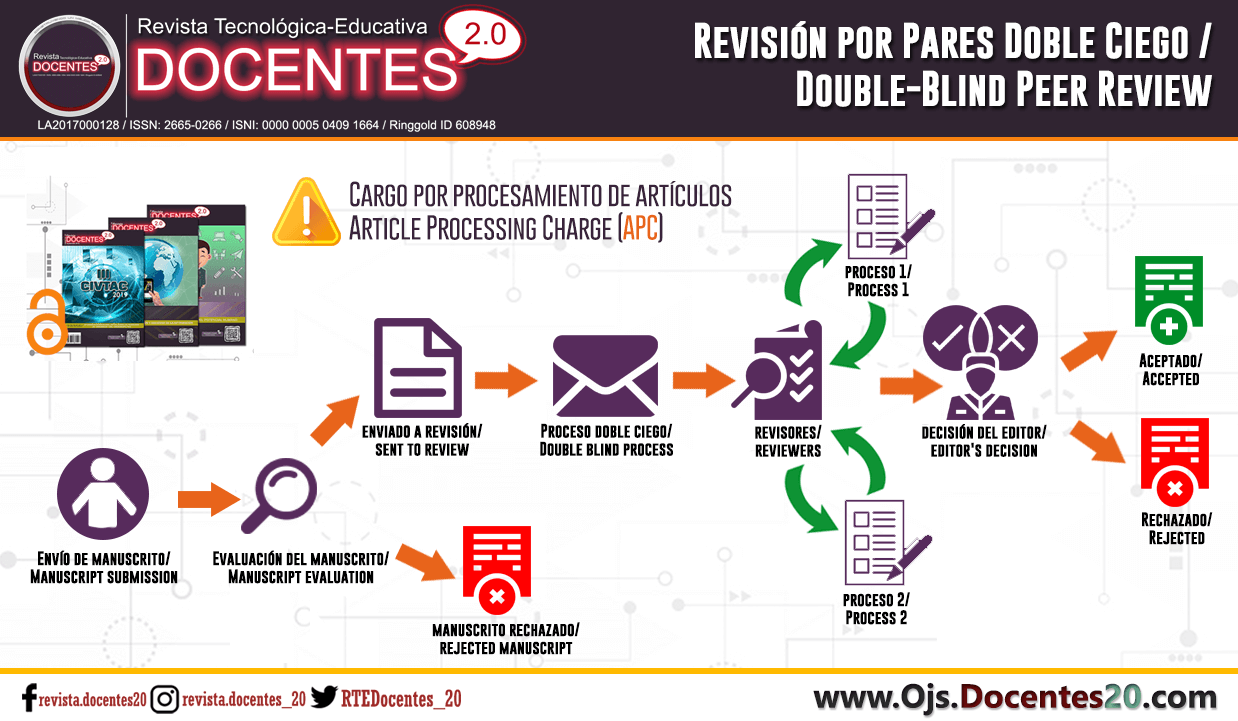Peer Review Proccess

The Technological-Educational Journal Docentes 2.0 follows a double-blind peer review process, ensuring that both the authors’ and reviewers’ identities remain mutually concealed throughout all evaluation stages. This process guarantees impartiality, objectivity, and academic rigor in manuscript assessment, following the Principles of Transparency and Best Practice in Scholarly Publishing and the Committee on Publication Ethics (COPE) Guidelines.
Before assignment to reviewers, all manuscripts undergo an originality check using specialized plagiarism detection software, as well as a thematic relevance check to confirm alignment with the declared scope of the journal.
Stages of the process
-
Initial screening: The Editor-in-Chief verifies compliance with formal requirements, thematic relevance, and originality. Manuscripts failing to meet these criteria are rejected before peer review.
-
Reviewer assignment: Each manuscript is assigned to a minimum of two external reviewers who are experts in the subject area. The majority of reviewers are external to the publishing institution, ensuring the independence and objectivity of the process. Only in exceptional cases may internal reviewers be considered, provided that they declare the absence of conflicts of interest.
-
First review: The first referee issues their report and recommendations, which are forwarded to the author for revision.
-
Second review: The revised manuscript is sent to the second referee, who provides further evaluation and comments.
-
Editorial decision: The Editor-in-Chief, based on both evaluations, decides whether the manuscript is accepted, accepted with minor changes, returned for major revisions and re-review, or rejected.
-
Final corrections: The author submits the definitive version along with a detailed response letter addressing each reviewer’s comment.
-
Publication: Once accepted, the article is assigned a DOI and scheduled for publication in the corresponding issue.
Evaluation Criteria
-
Originality and relevance of the subject.
-
Alignment with RTED’s scope (Education, Technology, and Social Sciences).
-
Methodological rigor and scientific quality.
-
Expository clarity and logical coherence.
-
Relevance, currency, and pertinence of cited references.
-
Compliance with the journal’s template and editorial guidelines.
Transparency and Traceability
All published articles include an editorial note certifying that they were evaluated under the double-blind system by two external reviewers. The reviewer database is updated annually to ensure institutional and geographic diversity, preventing frequent authors from serving as reviewers close to their publication periods.
Estimated Timeframes
The complete process, from manuscript submission to the final editorial decision, averages four (4) to six (6) months, and may be extended if additional review rounds are required to guarantee scientific quality.
Communication with Authors
Authors are notified of the status of their manuscript at every stage of the process (initial screening, peer review, revision requests, acceptance, or rejection).
Review Languages
The journal accepts and reviews manuscripts in Spanish and English.
Conflicts of Interest and Ethics
All reviewers and members of the editorial team must declare potential conflicts of interest and refrain from participation if such conflicts exist.
Declaration and Reviewer Policies
All reviewers must complete and sign the Reviewer Ethics Declaration Form before starting their work, confirming their commitment to confidentiality, impartiality, and the absence of conflicts of interest.
In addition, reviewers are required to comply with the Reviewer Policies, which establish ethical standards, evaluation guidelines, deadlines, and responsibilities during the review process.
